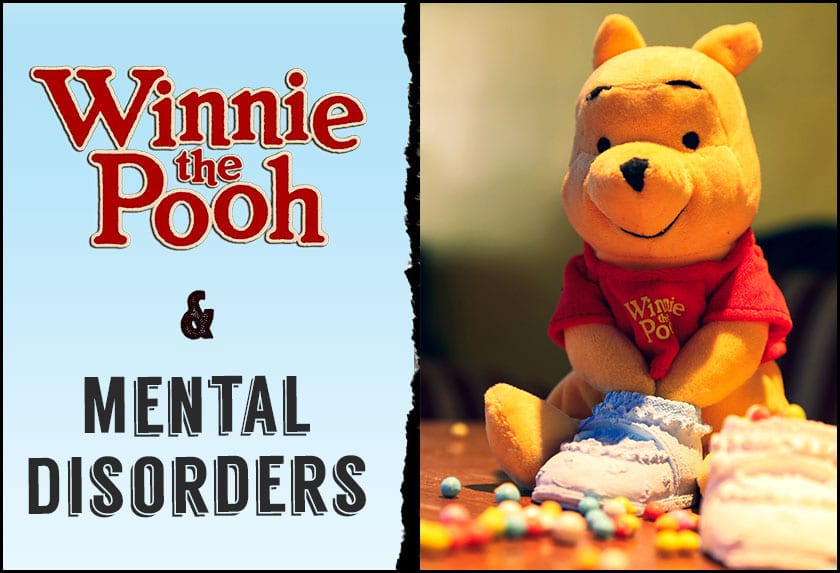Unpacking Winnie The Pooh's Pals: Mental Disorders Explored
Is it possible that the Hundred Acre Wood, a place of whimsical adventures and honey-loving bears, is, in fact, a microcosm of various mental health challenges? The inhabitants of Winnie the Pooh, beloved by generations, might not simply be charming characters; they could be reflections of psychological conditions, offering a unique and thought-provoking perspective on mental disorders.
The enduring appeal of A.A. Milne's creation stems from its relatable characters, each possessing distinct personalities and quirks. However, viewed through a modern lens, these quirks transform into potential representations of complex psychological issues. The gentle bear himself, Winnie the Pooh, might exhibit symptoms of attention-deficit/hyperactivity disorder (ADHD). Eeyore's perpetual melancholy suggests potential depressive tendencies. Piglet's anxieties and worries point to generalized anxiety disorder, while Tiggers boundless energy and impulsivity could be indicative of bipolar disorder. Even the wise owl, Owl, might be seen as demonstrating signs of narcissistic personality disorder, in how he carries himself and how he addresses other characters. Through their adventures, these characters navigate emotional landscapes, mirroring the experiences of real people struggling with their own mental health.
Lets delve into the character traits and explore how they might align with potential psychological diagnoses. It's important to remember that this is an interpretive exercise, not a definitive clinical analysis. However, by examining these beloved characters through a psychological lens, we can gain a deeper appreciation for the complexities of mental health and the challenges faced by individuals experiencing these conditions. The purpose isn't to pathologize these characters but to use them as a springboard for understanding and empathy.
Consider the character of Winnie the Pooh. The bear's focus on honey, his tendency to get distracted, and his forgetfulness could be seen as symptoms of ADHD. He struggles with organization and often loses track of his tasks, mirroring the challenges faced by individuals with ADHD. His impulsive behaviors, such as his immediate pursuit of honey, could also be considered. Pooh's overall optimism, however, suggests that even those facing challenges can find joy in life. This contrasts with the next character, Eeyore, whose character is in stark contrast.
Eeyore, the perpetually gloomy donkey, embodies a spectrum of depressive symptoms. His persistent sadness, lack of motivation, and pessimistic outlook are classic indicators of depression. His low self-esteem and feelings of hopelessness paint a picture of the emotional struggles associated with this prevalent mental health condition. Eeyore's character also illustrates the importance of empathy and support for those battling depression, especially from his friends. His frequent downcast and pessimistic views can sometimes be a burden for his friends.
Piglet, the timid and anxious pig, represents the experience of generalized anxiety disorder. His constant worry, fear of the unknown, and tendency to overthink situations are classic symptoms of the condition. Piglet's anxieties often drive his behavior, creating a picture of how anxiety can impact daily life and relationships. His character shows the challenges that can make everyday tasks overwhelming and difficult for a person.
Tigger, with his boundless enthusiasm and tendency to bounce before thinking, brings a different set of concerns. His impulsivity, exuberance, and difficulty with focus could be considered indicative of a manic phase in bipolar disorder or other conditions. Tigger's high energy and need for excitement make it difficult to stay calm and focused, impacting interactions and decision-making. His character serves as an illustration of the need for balanced mental health management.
Owl, the self-proclaimed wise one, might be seen as a demonstration of narcissistic traits. His tendency to lecture others, his inflated sense of self-importance, and his need for admiration align with characteristics of narcissistic personality disorder. Owl frequently reminds the other characters of his 'wisdom' and can be dismissive of their concerns, representing the challenges in interactions with people dealing with such personality traits. His character teaches the importance of humility and genuine connection.
Christopher Robin, the only human in the Hundred Acre Wood, serves as the voice of reason and a grounding force for the other characters. He demonstrates understanding and empathy towards his friends, offering support and guidance. Christopher Robins presence highlights the importance of social connection and the positive impact of supportive relationships on mental well-being.
The exploration of these characters through a psychological lens offers a unique opportunity to examine mental health. By recognizing potential connections between the characters and various conditions, we can gain a deeper understanding of the emotional struggles faced by people living with these conditions. This interpretive framework, however, is not meant to diagnose but to foster empathy and appreciation for the complexities of mental health.
The appeal of Winnie the Pooh endures because of the exploration of universal human emotions. These stories, when seen through a psychological lens, provide unique and thought-provoking perspectives on mental health, creating opportunities for discussion and empathy.
The Hundred Acre Wood is not just a world of fantasy. It is also a reflection of the challenges that people face. These challenges are not always obvious and can go unnoticed, but understanding how to approach them can help bring understanding and awareness.
| Character | Potential Psychological Representation | Associated Symptoms | Impact on Behavior |
|---|---|---|---|
| Winnie the Pooh | Attention-Deficit/Hyperactivity Disorder (ADHD) | Forgetfulness, distractibility, impulsivity, difficulty focusing, disorganization | Difficulty completing tasks, seeking instant gratification, and struggling with routines. |
| Eeyore | Depression | Persistent sadness, low self-esteem, hopelessness, lack of motivation, pessimism | Social withdrawal, difficulty experiencing joy, and a negative view of self and future. |
| Piglet | Generalized Anxiety Disorder | Excessive worry, fear of the unknown, nervousness, overthinking, physical symptoms of anxiety | Avoidance of social situations, difficulty making decisions, and constant state of unease. |
| Tigger | Bipolar Disorder (Possible Manic Phase) | Excessive energy, impulsivity, difficulty concentrating, rapid speech, inflated self-esteem | Engaging in risky behaviors, difficulty with routines, and strained relationships. |
| Owl | Narcissistic Personality Disorder (Possible) | Inflated sense of self-importance, need for admiration, lack of empathy, tendency to lecture | Difficulty maintaining healthy relationships, exploiting others, and a fragile self-esteem. |
| Christopher Robin | None (Represents Sanity and Empathy) | None | Provides support, understanding, and a grounding influence on the other characters. |
This analysis, though interpretive, is an illustration of how storytelling can reflect real-world psychological challenges. Using these beloved characters as a window into human behavior encourages discussion about mental health. The aim is to foster empathy and understanding, not to make formal diagnoses. By considering the possible psychological underpinnings of these personalities, we gain a deeper respect for the complexities of mental well-being. This can prompt conversations and offer insights that might inspire compassion and support for those facing such struggles.
The ongoing relevance of Winnie the Pooh highlights the enduring importance of understanding the human condition. By looking beyond the surface of the stories, we can uncover vital lessons about emotions, relationships, and mental well-being. The Hundred Acre Wood offers more than just a whimsical escape; it serves as a subtle reminder of the importance of empathy, support, and the need to care for our mental health.
The timeless appeal of these stories is also a result of the exploration of complex themes. They are relevant to all generations and can be enjoyed by people of any age. This timelessness offers insights and conversations on difficult themes.


